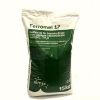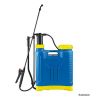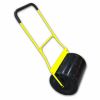How to Control Moss on Your Lawn
Index
- Factors Leading to Moss Growth
- Short Term Moss Control
- Long Term Moss Control
The build up of moss is caused by a number of factors. In any particular garden, one or all of these factors could be influencing the levels of moss growth. To control moss these factors will need to be resolved, otherwise moss growth will re-occur, even after scarification or moss removal.
Factors Leading to Moss Growth
- Overly wet soil - This is the most common factor. Poor drainage will lead to damp soil. This reduces grass growth and leads to moss exploting bare soil. Moss need wet conditions for spores to spread & reproduce
- Soil compaction - Excessive traffic or use of lawns can lead to compacted soil. This makes grass growth more difficult and leads to damp soil which again encourages moss growth
- Cutting grass too low - Overly enthusiastic grass cutting. Often we cut our grass too short, especially the first cut of the year, which should only see the grass being topped. But far too often I see lawns being somewhere between white & yellow in colour after a first cut. This is not suitable, it will stress out the grass, reducing growth & lead to moss growth. Scalping grass will also lead to moss
- Low fertility - lots of food (i.e. Nitrogen) means lots of healthy grass blades and as a result less moss on your grass
The above factors need to be resolved to ensure long term moss control. But before we concern ourselves with the long term, we need to solve the short term issue of moss on our lawns.
Short Term Moss Control
- Apply sulphate of iron (Or ferrous sulphate or ammonium sulphate) This is a wonderfully easy way to kill moss on your lawns. This powder can be applied in Winter to late Spring and will kill moss off in under 2 weeks. Apply on a calm day, either by hand or using a broadcast spreader. 35 grams per m2 is sufficient. The dead moss will need to be raked out afterwards
- Alternatively you can apply diluted Armillatox. Apply using a knapsack sprayer
- Once the moss has died back you can remove it by scarification. See our article on how to scarify in the lawn care section
- As you can read in the related article, you should re-seed your lawn after scarification
Long Term Moss Control
Create the ideal growing conditions for your grass. Your soil should be light, free draining, fertile and warm.
- Ensure that you never remove more than 1/3 of grass in any one cut
- Apply nitrogen based fertiliser every month between April & July
- Aerate your lawn each year in either Spring or Autumn (see our how to aerate tutorial)
- If your soil is consistently wet and / or is slow to drain after a rain shower then you should consider installing land drains
- Your lawn should never become water logged
- Surface water should drain away at a rate of 1 inch per hour
- You can do a 'matchstick' test to determine soil compaction - you should be able to push a matchstick into your soil using only your thumb
- Choose the right lawn seed for you. If your lawn is going to get excessive use and could have kids playing football on it and BBQ's & picnics are a common event, then you should choose a hard wearing grass such as a grade 3 grass, as what would be used on a football pitch. Grade 1 is more suited to manicured lawns and those which will receive little foot traffic
- Warm soils mean better grass growth. Grass will grow when the soil temperatures reach 6 degrees. But Optimum growth is reached between 18 & 22 Degrees









